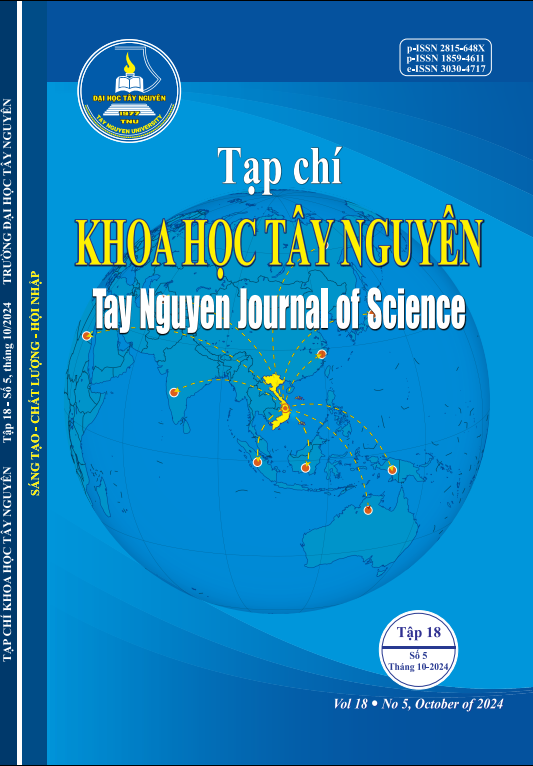Tối ưu hóa môi trường nuôi cấy chủng vi khuẩn vùng rễ Priestia aryabhattai RB.HP54 để tăng khả năng sinh tổng hợp IAA
Main Article Content
Tối ưu hóa môi trường nuôi cấy chủng vi khuẩn vùng rễ Priestia aryabhattai RB.HP54 để tăng khả năng sinh tổng hợp IAA
Tóm tắt
Nghiên cứu được tiến hành với mục tiêu tìm ra giá trị tối ưu của các yếu tố môi trường nuôi cấy tác động trực tiếp đến sinh tổng hợp IAA của chủng vi khuẩn vùng rễ Priestia aryabhattai RB.HP54 làm tiền đề tạo chế phẩm sinh học ứng dụng trong sản xuất. Kết quả khảo sát các đơn yếu tố của môi trường cho thấy, chủng RB.HP54 sinh trưởng và tổng hợp IAA tốt trong môi trường có thành phần glucose 5g/L, pepton 7,5 g/L và L- tryptophan 1 g/L, pH 6,5 -7. Ba yếu tố có tác động lớn nhất đến hàm lượng IAA (glucose, pepton và L-tryptophan) được tối ưu hóa bằng phương pháp đáp ứng bề mặt (RSM) và sử dụng thiết kế Box – Behnken. Kết quả phân tích cho thấy, phương trình hồi quy đa biến có dạng IAA (mg/L) = 66,98 -1,81A +3,09B + 4,17C +3,46AB – 1,27AC – 0,4625BC – 6,06A2 – 1,39B2 – 5,74C2. Mô hình dự đoán hàm lượng IAA tối đa đạt 68,955 mg/L và thực tế thí nghiệm thu được IAA có hàm lượng 71,417 mg/L khi chủng RB.HP54 được nuôi cấy trong môi trường có thành phần glucose 4,97 g/L, pepton 8,97 g/L và L-tryptophan 1,07 g/L.
Article Details

Tác phẩm này được cấp phép theo Giấy phép quốc tế Creative Commons Attribution-NonCommercial-NoDeri Phái sinh 4.0 .
Tài liệu tham khảo
- Trương Phước Thiên Hoàng, Lê Phước Thọ, Vũ Phú Quang, Nguyễn Phú Hòa, Nguyễn Văn Thống, Phạm Công Hoạt (2021).Tối ưu hóa thành phần môi trường lên men thu sinh khối vi khuẩn Pseudomonas stutzeri bằng phương pháp đáp ứng bề mặt (RSM). Tạp chí Khoa học Nông nghiệp Việt Nam, 19(11): 1509-1521
- Đỗ Tất Thịnh, Lê Xuân Sơn, Trần Thị Nhàn, Nguyễn Thị Kim Oanh, Nguyễn Văn Hiếu (2023). Tuyển chọn và xác định đặc điểm sinh học của một số chủng vi khuẩn có khả năng sinh Indole-3-acetic acid (IAA). TNU Journal of Science and Technology, 228(13): 162 – 169.
- Trần Linh Thước (2007). Phương pháp phân tích vi sinh vật trong nước, thực phẩm và mỹ phẩm. NXB Giáo dục
- Bhutani, N., Maheshwari, R., Negi, M., & Suneja, P. (2018). Optimization of IAA production by endophytic Bacillus spp. from Vigna radiata for their potential use as plant growth promoters. Israel journal of plant sciences, 65(1-2), 83-96.
- Duca, D., Lorv, J., Patten, C. L., Rose, D., & Glick, B. R. (2014). Indole-3-acetic acid in plant–microbe interactions. Antonie Van Leeuwenhoek, 106, 85-125.
- Glickmann, E., & Dessaux, Y. (1995). A critical examination of the specificity of the Salkowski reagent for indolic compounds produced by phytopathogenic bacteria. Applied and environmental microbiology, 61(2), 793-796.
- Esikova, T. Z., Anokhina, T. O., Abashina, T. N., Suzina, N. E., & Solyanikova, I. P. (2021). Characterization of soil bacteria with potential to degrade benzoate and antagonistic to fungal and bacterial phytopathogens. Microorganisms, 9(4), 755.
- Idris, E.E., Iglesias, D.J., Talon, M., Borriss, R. (2007). Tryptophan-Dependent Production of Indole-3- Acetic Acid (IAA) AffectsLevel of Plant Growth Promotion by Bacillus amyloliquefaciens FZB42. Mol. Plant-Microbe Interact. 20:619–626.
- Lakshmanan, R., Poyil, M. M., Kalaimurugan, D., Sivasankar, P., Ponmurugan, K., & Venkatesan, S. (2022). Optimization, Characterization and Quantification of Indole Acetic Acid Produced by a Potential Plant Growth Promoting Rhizobacterium Bacillus safensis YKS2 from Yercaud Hills, Eastern Ghats. Journal of Pure & Applied Microbiology, 16(3).
- Nsa, I. Y., & Omolere, B. M. (2023). Draft genome sequence and annotation of Priestia aryabhattai strain BD1 isolated from a dye sediment. Microbiology Resource Announcements, 12(2), e01175-22.
- Cuong, P. V., & Hoa, N. P. (2021). Optimization of culture condition for iaa roduction by Bacillus sp. isolated from cassava field of Vietnam. Vietnam Journal of Science and Technology, 59(3), 312-323.
- Poria, V., Dębiec-Andrzejewska, K., Fiodor, A., Lyzohub, M., Ajijah, N., Singh, S., & Pranaw, K. (2022). Plant Growth-Promoting Bacteria (PGPB) integrated phytotechnology: A sustainable approach for remediation of marginal lands. Frontiers in Plant Science, 13, 999866.
- Reji, M., & Kumar, R. (2022). Response surface methodology (RSM): An overview to analyze multivariate data. Indian J. Microbiol. Res, 9, 241-248.
- Wagi, S., & Ahmed, A. (2019). Bacillus spp.: potent microfactories of bacterial IAA. PeerJ, 7, e7258.
- Shahid, M., Zeyad, M. T., Syed, A., Singh, U. B., Mohamed, A., Bahkali, A. H., ... & Pichtel, J. (2022). Stress-tolerant endophytic isolate Priestia aryabhattai BPR-9 modulates physio-biochemical mechanisms in wheat (Triticum aestivum L.) for enhanced salt tolerance. International Journal of Environmental Research and Public Health, 19(17), 10883.
- Srithaworn, M., Jaroenthanyakorn, J., Tangjitjaroenkun, J., Suriyachadkun, C., & Chunhachart, O. (2023). Zinc solubilizing bacteria and their potential as bioinoculant for growth promotion of green soybean (Glycine max L. Merr.). PeerJ, 11, e15128.
- Suliasih and S Widawati (2020). Isolation of Indole Acetic Acid (IAA) producing Bacillus siamensis from peat and optimization of the culture conditions for maximum IAA production. In IOP Conference Series: Earth and Environmental Science (Vol. 572, No. 1, p. 012025). IOP Publishing.
- Ton That Huu Dat, Nguyen Thị Kim Cuc, and Pham Viet Cuong (2015). Optimization of indole-3-acetic acid production by Bacillus subtilis TIB6 using response surface methodology. International Journal of Development Research, 5(4), 4036-4042.
- Wang, H., Liu, R., You, M. P., Barbetti, M. J., & Chen, Y. (2021). Pathogen biocontrol using plant growth-promoting bacteria (PGPR): Role of bacterial diversity. Microorganisms, 9(9), 1988.



